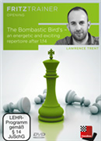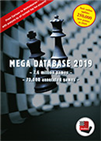A review of the Ne2 Caro-Kann
Tricky ideas, and the occasional wacky weapon should be in the arsenal of any aspiring master-level player. Why? Because through playing and analysing the "strange-looking, thought-it-was-incorrect" lines we learn more about the strong and weak points of traditional mainlines.
 Welcome to the Bombastic Bird's, a revolutionary repertoire for one of the most enterprising and underrated openings in chess theory (1.f4). In this series, IM Lawrence Trent uncovers a number of groundbreaking theoretical novelties and new ideas that will soon have scorners of this romantic system regretting they ever doubted its soundness.
Welcome to the Bombastic Bird's, a revolutionary repertoire for one of the most enterprising and underrated openings in chess theory (1.f4). In this series, IM Lawrence Trent uncovers a number of groundbreaking theoretical novelties and new ideas that will soon have scorners of this romantic system regretting they ever doubted its soundness.Instead, many commit the mistake of playing one opening all their lives, and at a certain point discover they are not progressing, because they didn't internalize the diverse ideas, structures, and patterns, which one needed in order to become a complete player.
The point is not to find a refutation to any particular opening, but to open our minds to the many different ways one can play — in short, to achieve a better chess understanding.

Rapid-fire opening study!
For IM Lawrence Trent having just one hour means a fast-paces explanations of lines and the reasoning behind the moves, as well as transpositions into other openings. For example, after 1.e4 c6 2.♘e2 e5 3. d4 d6 now White can continue with 4.♘bc3 ♞f6 transposing into a Pirc. It reminds us we are not in a Caro-Kann any more, and we need to switch mindset.
So, how should White continue?
- 5.a4 to stop Black's expansion on the queenside?
- Or 5.g3 to develop the Bf1?
- Or 5.h3 preventing Black from playing ♗g4, and eventually expanding with g4?
Try against the engine, and see what you think:
Trent also shows how we can enter the King's Indian Defence (KID), after the moves: 1.e4 c6 2.♘e2 e5 3. d4 d6 4.c4!? g6 5.♘bc3 ♝g7 6.♗e3 ♞f6 7.f3 0-0, and we are in the Saemisch line of the KID:
This is an important point for me, as a player aiming to keep my mind flexible and be able to recognize different structures before my opponent. To learn ways to deal with variety, one should practice like a drill, against an engine, as in the above diagram.
But as always with openings, one must also have a reference, games played in those lines by top GMs who can show the ideas. Again this is not specific to the Caro-Kann, but in this engine era, a player needs to be as universal as possible.
Obviously, the main focus of this repertoire comes after the typical Caro-Kann answer: 1.e4 c6 2. Ne2 d5
Trent says the idea of this opening is to play 3.e5, posing to Black the question: "What is your next move?"
He skilfully covers and illustrates all possible Black replies. Here I'm not going to copy his work, instead, I'll share some games played by the practitioners of 2.♘e2 against the replies played by Black, to give a roadmap to a future 2.♘e2 player to navigate the obstacles, as well as the plans White can adopt. After 1.e4 c6 2.♘e2 d5 3.e5 g6 — an underrated move, says Trent.
As always, thanks to ChessBase's tools, one can train using some positions from the DVD against the engine. Here are the games for those who want to gain insight:
Click or tap a game in the list to switch
Just to reiterate the point, Trent did a good job with the analysis, even finding some novelties. The review is to give a general outlook on the main lines, but of course I'm only scratching the surface of the video series.
Trent presents some stunning combinations and manoeuvres too. Try to find how White should continue, playing against the engine:
It is important to familiarize yourself with the material, because Trent does cover a lot, and there will be a little homework required. For example after the moves: 1.e4 c6 2.♘e2 d5 3. e5 ♝f5 how to continue?
It could feel natural to continue with d4, but Trent suggests 4.♘g3 to which generally Black replies with 4...♝g6 and 5.h4 h6 (also h5 is playable, so one needs to look for games with that line, and discover what are the themes and ideas) 6.h5 ♝h7 7.e6 fxe6 — this is the position I wanted to show. This sacrifice is typical in the Caro-Kann, and if one doesn't have any idea of the compensation on offer, it is important to stop watching the video and see some games, or let the engine play the White side, and get an understanding of the potential in such a trade.
I offer a small sample of games, to give an example of how to study, many more can be found with a simple search in MegaBase 2019:
 The "Mega" is the database every serious chessplayer needs. The database contains 7.6 million games from 1500 to 2018, in highest quality standard, full of top level analyses and completely classified.
The "Mega" is the database every serious chessplayer needs. The database contains 7.6 million games from 1500 to 2018, in highest quality standard, full of top level analyses and completely classified.Returning to the previous h5 move, after the moves: 1.e4 c6 2.♘e2 d5 3. e5 ♝f5 4.♘g3 ♝g6 5.h4 h5 if now White continues with: 6.d4 e6 7.c4 this is a main line of the advance variation in the Caro-Kann.
Obviously, Trent wouldn't be able to cover all the lines in the Advance Variation, but in this case, another great teacher, Victor Bologan, made a DVD on the Advance Caro-Kann with really detailed plans — another ChessBase FritzTrainer worth studying.
The Caro-Kann Defence is one of the most solid replies for Black after 1.e4. Bologan's choice of the Advance Variation for White is because of the complex strategical play in which White has a long-term space advantage.
Summarizing the content of the DVD: One gets five videos for a total of one hour of opening theory, and four extra videos of exercises. There is also a database with 63 games!
Pros and Cons
I disagree with Trent on one statement he made, at 7 minutes 50 seconds of the second video. He says: "Caro-Kann players are very unlikely to have the KID in their repertoire..." in reference to a transposition from the Caro-Kann to the KID.
This is simply not true, because Caro-Kann players do need to have a repertoire against 1.d4, and their repertoire could be based on the KID, which is a very popular opening (in fact I do happen to know a master level player in my area who plays both).
The DVD prepared by Trent is "rich" in my opinion — meaning there is more material than our minds can absorb in one hour. A thorough study of the DVD could take as much as 10 or more hours, and then, of course, one needs to practice with some games. Or at least one should space the learning, maybe watch all the videos in 1 hour, and then after a couple of days to do it again, to see what was forgotten, and to reinforce the material.
Final thoughts
One very important chess task we all need to accomplish is to keep up our curiosity. Improvement comes when we are curious to discover new ideas, be they in the opening or the endgames typically arose from those openings. Everyone can spare one hour to listen to an IM giving us some ideas on how to play against the Caro-Kann. Thanks to the games and positions presented in this review, one can complement Trent with some hands-on experience. Of course actually learning to play 2.♘e2 will require more time, and maybe some blitz games for practice, completely with analysis in the end.
Caro-Kann players typically love their solid structures and modest setups, but with this bamboozling sideline they will be forced to enter unknown territory right from the off!
Links
.jpeg)






















